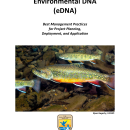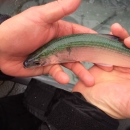States
Alaska, Georgia, New Mexico, Pennsylvania, Washington, WisconsinEnvironmental DNA, or eDNA for short, is a tool that can be used to monitor for the genetic presence of a species in the environment.
This emerging technology looks for the presence of DNA from either a specific species or a group of species that has been “shed” into the environment. There are many ways that a species can leave behind DNA in an environment. They can shed skin cells, scales, or fecal material directly from the organism into the water, or their genetic material can be indirectly transferred by boats, sediment, or even fecal matter of another organism. The use of eDNA to detect species of interest can help monitor species ranges, assess the makeup of a community, and inform priorities for focused traditional habitat, population or invasive species invasive species
An invasive species is any plant or animal that has spread or been introduced into a new area where they are, or could, cause harm to the environment, economy, or human, animal, or plant health. Their unwelcome presence can destroy ecosystems and cost millions of dollars.
Learn more about invasive species monitoring.
U.S. Fish and Wildlife Service Conservation Genetics Labs work with internal and external partners to process thousands of samples each year for monitoring of invasive and native species of concern.
We work with partners to implement large-scale monitoring programs for invasive species, like the invasive carp monitoring program that was adopted in 2013. In addition to invasive species, eDNA has been used to monitor the distribution of native species such as brook trout, American eel, and various freshwater mussels.
FAC develops standard operating protocols and best practices for all phases of eDNA projects and leads trainings on eDNA technology in conservation. This expertise drives the Service’s role as a leader in large-scale, national eDNA efforts. eDNA is an exciting technology with rapidly growing applications and the Service is partnering with other agencies on projects including the National Early Detection Rapid Response Framework (EDRR Framework) and National Aquatic eDNA Strategy. We have multiple eDNA labs currently operating within the FWS, and will be expanding our capacity to meet the growing interest of natural resource managers to incorporate this tool into monitoring.
- Alaska Conservation Genetics Lab
- Northeast Fishery Center Conservation Genetics Lab
- Whitney Genetics Lab
U.S. Fish and Wildlife Service Conservation Genetics Community of Practice
The U.S. Fish and Wildlife Service Conservation Genetics Community of Practice is spread across six regional genetics labs and the staff at the Service’s National Fish and Wildlife Forensics Lab. For over a decade these facilities have been pioneering genetics research to benefit the conservation of fish, wildlife, and plants.








